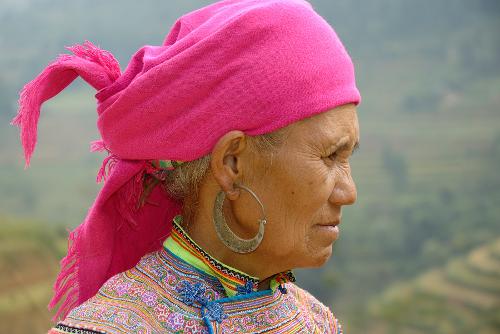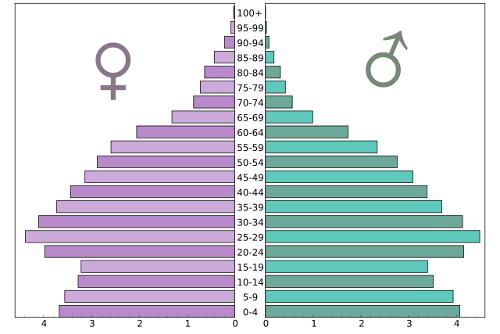VIETNAM
Population

Population
Cities in VIETNAM
| Hanoi |
Population
Composition
 VietnamesePhoto: Jspeed1310 CC 2.0 Generic no changes made
VietnamesePhoto: Jspeed1310 CC 2.0 Generic no changes made
Vietnam has 54 ethnic groups and the group of ethnic Vietnamese (Viet or Kinh = inhabitants of the plain) is by far the largest group (approx. 85.7%). Most Viet live in the deltas of the Red River and Mekong and the central coastal plain.
The Vietnamese people descend from many races and ethnic groups that have been amalgamated from the beginning of our era. The Viet include Thai, Malay, but mainly Chinese groups. Over the centuries they moved south from the north of Vietnam. The culture of the Viet has always been strongly influenced by the Chinese.
The approximately 1 million Chinese mainly live in the cities in the south of the country. After a serious border dispute between China and Vietnam, many Chinese entrepreneurs left the country in the late 1970s. Several thousand Chinese have retained their Chinese nationality; the rest have taken Vietnamese citizenship and are called Hoa. Most Chinese live in Cho Lon, a district of Ho Chi Minh City, where they have often established themselves as shopkeepers or traders.
 Montagnards children, VietnamPhoto: DXLINH CC 3.0 Unported no changes made
Montagnards children, VietnamPhoto: DXLINH CC 3.0 Unported no changes made
The inhabitants of the hills and mountains of central and northern Vietnam, called "moi" or savages by the ethnic Vietnamese, together form the largest minority in the country. These so-called Montagnards are closely related to ethnic groups in Thailand and South China. The semi-nomadic hill dwellers generally have a low standard of living and live mainly from shifting cultivation (slash and burn), but also from hunting and fishing. Ancestor worship and animism are still common, but Christianity has also penetrated these groups. Each group has its own clothing, jewelry, language and religion. The situation of the Vietnamese mountain peoples has improved somewhat after the former economic and cultural disadvantage. They are allowed to wear their traditional clothing and speak their own language again. Nowadays, people from minorities also study at universities and they are also allowed to sit in parliament and representative bodies. At the end of the 20th century, an ethnic group of less than a hundred members was discovered in a northern province.
The Montagnards can be divided into three language groups:
Austro-Asiatic language group
These include the Muong, one of the oldest ethnic groups in the country. They mainly live in Hoa Binh province.
The Tay of Tho and the Nung live in the north of Vietnam, close to the border with China. They live in stilt houses, mainly live from rice cultivation and further grow soybean, cinnamon, tea, tobacco and cotton. The Nung speak the same language as the Tay and have the same culture and customs.
The Thai live in the river valleys around Sonla, Lai Chau and Lao Cai in northwestern Vietnam. Their houses are built on stilts; the houses of the Black Thai are in the shape of a turtle shell, while the houses of the White Thai are rectangular. Hmong, VietnamPhoto: Christophe Meneboeuf CC-BY-SA 3.0 no changes made
Hmong, VietnamPhoto: Christophe Meneboeuf CC-BY-SA 3.0 no changes made
The Hmong or Meo (ca. 600,000) live mainly in the highlands of the northern provinces, in ordinary houses. They have no written language and the ancestor worship and spirits play an important role in the daily life of these people. There is also totemism, the worship of symbolic objects. Legends and songs are passed on orally from generation to generation. Their staple food is corn and they are highly skilled artisans. The Hmong wear colorful, very beautiful clothes.
The Dao or Mien do have a written tradition and they live on the hills of the northern provinces as well as in the valleys. They grow rice according to the shifting cultivation method and are very skilled craftsmen. What is special is that they make their own paper and have used Chinese characters for centuries to record all kinds of expressions.
Sino-Tibetan language group
Most of these groups migrated from Tibet via Myanmar (formerly: Burma) to Northern Vietnam in the 18th and 19th centuries and now live in the northern and northwestern provinces of Lai Chau and Lao Cai. This language group includes the La Hu, the Phu La, the Lolo, the Cong, the Si La and the Ha Nhi.
Austronesian or Malay-Polynesian language groups
These groups live in central and southern Vietnam and include the Jarai (or Gia Rai), the Sedang de Bahnar and the Rha De (or E De). Together these four tribes number about 750,000 souls.
The Jarai migrated from the coast to the highlands about 2,000 years ago and now live in villages of at least 50 houses built around a centrally located community house or "nga rong". The day-to-day affairs are regulated by a council of elders, headed by a village chief. They are farmers but they also keep water buffaloes, goats, chickens and pigs.
The Rha De live mainly in the province of Dac Lac and their villages consist of 20 to 70 "longhouses" built on stilts. In each longhouse lives a family headed by a "koa sang", the oldest woman. Each village has an autonomous government headed by a "po pin ao", a village chief chosen by the villagers. They live from shifting cultivation and rice is the main food crop, along with cotton, sugar cane, tobacco and melons.
 Ham girl, VietnamPhoto: Dalbera CC 2.0 Generic no changes made
Ham girl, VietnamPhoto: Dalbera CC 2.0 Generic no changes made
The Cham and the Khmer are separate groups. The habitat of the Cham is the coastal strip from Phan Thiet to Nha Trang in South Vietnam and parts of the Mekong Delta; the Khmer inhabit the Mekong Delta.
The Ham, mostly Sunni Muslims, are the last descendants of the great and powerful kingdom of Ham (2nd to 15th century).
The Khmer were Hindu at first, but later converted to Theravada Buddhism. Due to the old enmities between Vietnamese and Khmer, it never clicked between these two populations. The same goes for Cambodia, where a Vietnamese minority has lived for many centuries.
Many Vietnamese live abroad, about two million. The large majority left in the period 1975-1984 as (boat) refugees, mainly to the United States and to France. Smaller numbers went to Germany, Canada and the Netherlands. In 1987 there was a second wave of boat people, mainly North Vietnamese. They were mainly fleeing bitter poverty and mainly fled to rich Hong Kong. Many governments refused to grant them asylum and from 1997 onward, other auspices of the High Commission for Refugees (UNHCR) followed the first "voluntary" repatriations. All this under a global storm of protests.
From 1989, these people (the so-called Viet Kieu) were allowed to return by the Vietnamese government.
In Vietnam there are also about 5,000 so-called "Amerasians", descendants of departed American soldiers and thus children of mixed race. They are called "dirt off the street" and often live in very difficult circumstances after being rejected by their mothers. Children of African American fathers are particularly struggling.
In 1987 the American Congress passed the "Amerasian Homecoming Act". This law allowed the arrival of all Vietnamese who can prove to have an American father to the United States. Tens of thousands of Vietnamese have used the scheme, along with about 60,000 family members.
Demographic data
 Population pyramid VietnamPhoto: MagHoxpox CC 4.0 International no changes made
Population pyramid VietnamPhoto: MagHoxpox CC 4.0 International no changes made
Vietnam had 105 million inhabitants in 2024, making it one of the top fifteen most populous countries in the world.
The average population density is about 320 inhabitants per km2. The coastal plains, the Mekong Delta and the Red River Delta (more than 1000 inhabitants per km2) have the greatest population density. The hill and mountain areas are sparsely populated, so that almost two-thirds of the total land area is inhabited by only 10 percent of the population.
The annual population growth between 1998 and 2014 was 1.4% (2024: 0.98%). Vietnam has a very young population. The average age of men is 73.5, women 78.9. (2024)
The age structure in 2024 is as follows:
| 0-14 years: | 23.2% | |
| 15-64 years: | 68.5% | |
| 65+: | 6.1% |
39.5% of the population lives in cities in 2024. The largest cities are Ho chi Min city with 9.3 million inhabitants, Hanoi with 5.2 million inhabitants. (2024)
Sources
Krücker, F.-J. / Vietnam
Elmar
Paulzen, H. / Vietnam : mensen, politiek, economie, cultuur, milieu
Koninklijk Instituut voor de Tropen
Peterse, L. / Vietnam
Gottmer/Becht
Te gast in Vietnam
Informatie Verre Reizen
Vietnam
Cambium
Vietnam
Lannoo
Wulf, A. / Vietnam
Het Spectrum
CIA - World Factbook
BBC - Country Profiles
Last updated November 2025Copyright: Team The World of Info